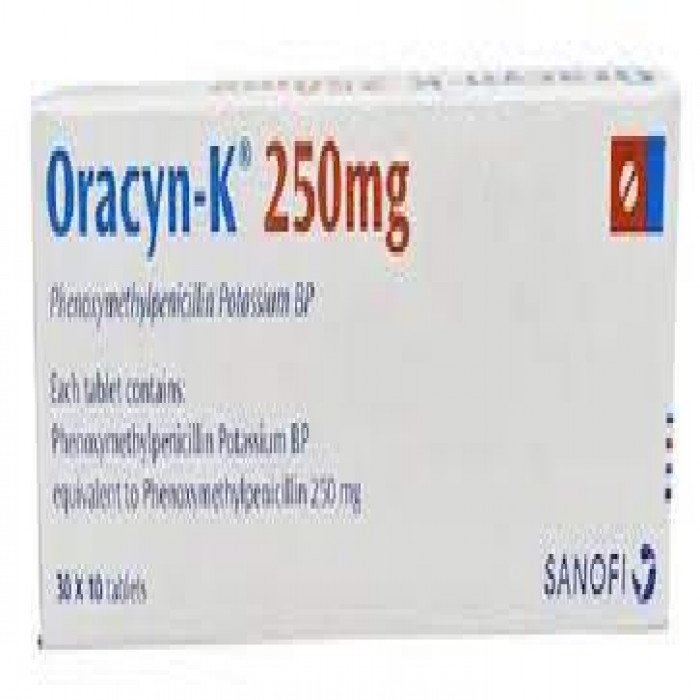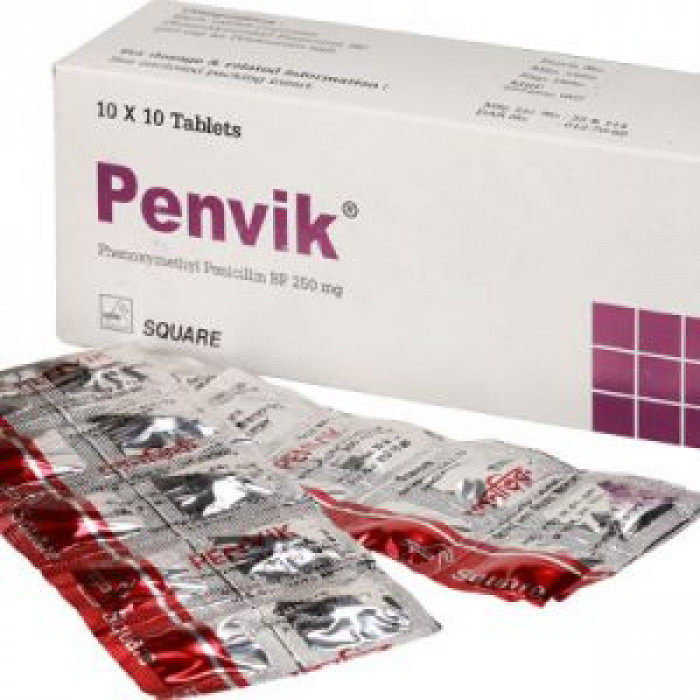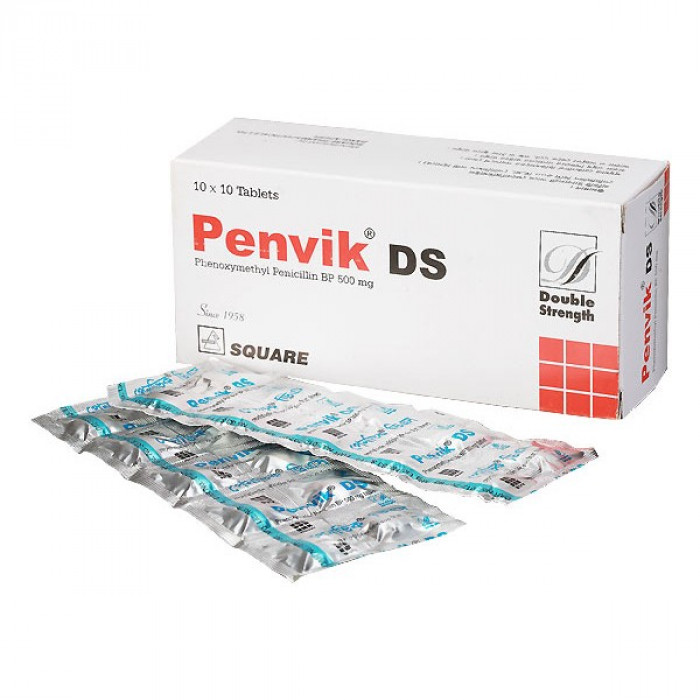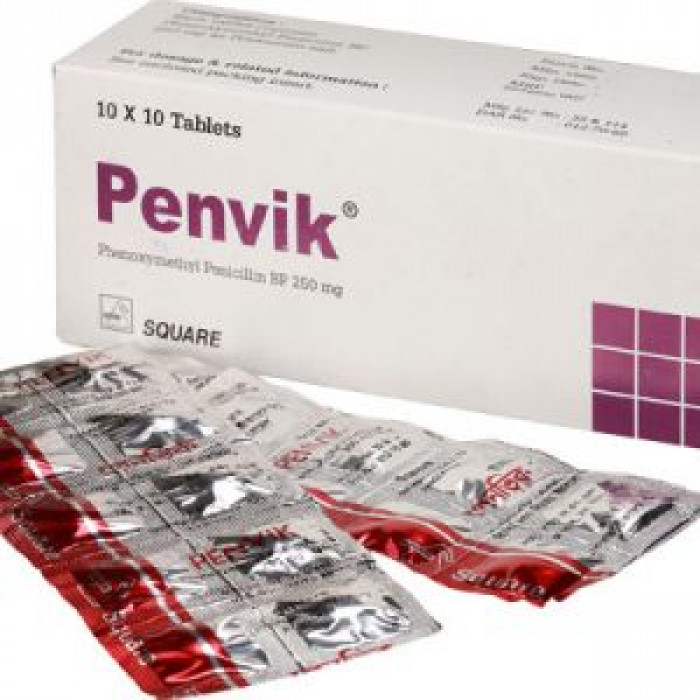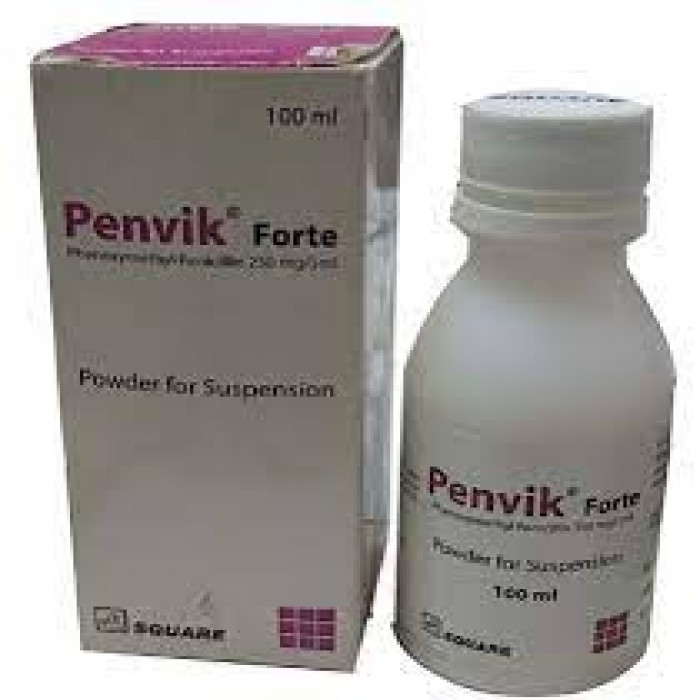
✔ 100% Authentic Product
👁️ Currently Viewing 2521
Penvik Forte Suspension
Suspension Manufacturer/Distributor: Square Pharmaceuticals Ltd. Generic Name: Phenoxymethyl Penicillin 250 mg/5 ml Powder For Suspension
Discount
Price: ৳ 80
MRP:
৳
84.43
5%
Off

100% Genuine Products, Guaranteed

Safe & Secure Payments, Always

Fast, Secure & Efficient Delivery

Proper Packaging
 Cash on Delivery - All over Bangladesh
Cash on Delivery - All over Bangladesh Regular Delivery - 12-24 Hours, Dhaka City* Charge Tk.39-59
Regular Delivery - 12-24 Hours, Dhaka City* Charge Tk.39-59 Regular Delivery - 24-48 Hours, Other Cities* Charge Tk.99-110
Regular Delivery - 24-48 Hours, Other Cities* Charge Tk.99-110
 ফ্রি ডেলিভারিঃ - ৯৯৯ টাকা+ অর্ডারে, ঢাকা
শহরে
ফ্রি ডেলিভারিঃ - ৯৯৯ টাকা+ অর্ডারে, ঢাকা
শহরে ফ্রি ডেলিভারিঃ - ২৯৯৯ টাকা+ অর্ডারে, ঢাকার
বাহিরে
ফ্রি ডেলিভারিঃ - ২৯৯৯ টাকা+ অর্ডারে, ঢাকার
বাহিরে
100% Genuine Products, Guaranteed
Safe & Secure Payments, Always
Fast, Secure & Efficient Delivery
Proper Packaging
 Cash on Delivery - All over Bangladesh
Cash on Delivery - All over Bangladesh Regular Delivery - 12-24 Hours, Dhaka City* Charge Tk.39-59
Regular Delivery - 12-24 Hours, Dhaka City* Charge Tk.39-59 Regular Delivery - 24-48 Hours, Other Cities* Charge Tk.99-110
Regular Delivery - 24-48 Hours, Other Cities* Charge Tk.99-110 ফ্রি ডেলিভারিঃ - ৯৯৯ টাকা+ অর্ডারে, ঢাকা
শহরে
ফ্রি ডেলিভারিঃ - ৯৯৯ টাকা+ অর্ডারে, ঢাকা
শহরে ফ্রি ডেলিভারিঃ - ২৯৯৯ টাকা+ অর্ডারে, ঢাকার
বাহিরে
ফ্রি ডেলিভারিঃ - ২৯৯৯ টাকা+ অর্ডারে, ঢাকার
বাহিরে
✅ Description:
Indications
For the treatment of mild to moderately severe bacterial infections caused by penicillin-susceptible pathogens that respond to oral penicillin therapy, such as tonsillitis, pharyngitis, laryngitis, otitis media, and sinusitis, as well as infections of the ear, nose, and throat.
Bronchitis, pneumonia, and bronchopneumonia are illnesses of the lower respiratory tract.
Scarlet fever, erysipelas, and rheumatic fever are all illnesses caused by beta-hemolytic streptococci of group A. Infections of the skin, such as pyodermia, furunculosis, phlegmon, erysipeloid, and erythema migrans, if the bacteria are penicillin-susceptible.
Lymphangitis and lymphadenitis caused by bacteria.Inflammatory infiltrates, delayed dentition stages II and III, antral fistulae, subsequent bacterial infection with Gram-positive pathogens following virus-induced gingivitis or stomatitis are examples of infections of the buccal cavity, gums, or jaws.
Scarlet fever prophylaxis; also to prevent recurrences of rheumatic fever. In some high-risk patients, for infection prevention after dental and oral surgical procedures or dental extractions (e.g. with congenital cardiac defects, artificial heart valves, rheumatic endocarditis). Combination with another appropriate antibiotic may be necessary in rare circumstances.
Pharmacology
Penicillin V (phenoxymethyl penicillin) is an acid-stable antibiotic that is absorbed from the top section of the small intestine. The potassium salt of Phenoxymethyl penicillin is the most absorbable of the several forms of Phenoxymethyl penicillin. This can be taken with or without food, however the best absorption occurs when the medicine is taken orally at least 1 hour before or 2 hours after the meal. Grampositive infections can be treated with phenoxymethyl penicillin, which is a highly convenient antibiotic. In terms of resistance to inactivation by stomach acid, phenoxymethyl penicillin has a considerable advantage over penicillin G.
Dosage
The dosage of Phenoxymethyl penicillin should be determined according to the sensitivity of the causative micro-organism and the severity of the infection, and adjusted to the clinical response of the patient.
Adults: 250-500 mg 6 hourly
Children (above 1 year):
125-250 mg 6 hourly
125 mg/5 ml powder for suspension: 1-2 teaspoonful (5-10 ml) 6 hourly
250 mg/5 ml powder for suspension: ½-1 teaspoonful (2.5-5 ml) 6 hourly
Infants (below 1 year):
62.5-125 mg 6 hourly.
125 mg/5 ml powder for suspension: ½-1 teaspoonful (2.5-5 ml) 6 hourly, or as prescribed by the physician.
Phenoxymethyl penicillin is best taken with an empty stomach, preferably at least 1 hour before or 2 hour after meal.
Administration
Phenoxymethyl Penicillin is best taken on an empty stomach, preferably one hour before meals. The tablets are swallowed without chewing with sufficient amounts of liquid. Before each use of this syrup, the bottle has to be shaken vigorously.
Interaction
Meals: Consumption of food at the same time reduces the rate of absorption. To get the highest potential rate of absorption, Phenoxymethyl penicillin should be taken on an empty stomach, ideally one hour before meals.
Concurrent administration of penicillins may result in higher amounts of methotrexate in the blood, potentiating its harmful effects. Methotrexate serum levels must consequently be monitored.
If diarrhoea occurs as a result of treatment with Phenoxymethyl penicillin, other orally administered medications' absorption may be disrupted, and their efficacy may be compromised. Penicillin activity may be reduced or eliminated when taken with bacteriostatic chemotherapeutics or antibiotics (e.g., tetracyclines, chloramphenicol). The renal excretion of penicillins is inhibited when probenecid is given at the same time. The use of indomethacin, phenylbutazone, salicylates, or sulfinpyrazone at the same time can result in high and sustained phenoxymethylpenicillin levels in the blood.
Contraindications
Patients who are hypersensitive to penicillins or any of the excipients should not be given phenoxymethyl Penicillin. Patients with severe gastrointestinal issues, including vomiting and diarrhea, should not be treated with phenoxymethyl penicillin.
Side Effects
Hypersensitivity reactions involving the skin (e.g. urticaria, morbilliform or scarlatiniform rashes, pruritus), eosinophilia, or more serious allergic reactions, such as drug fever, vasculitis, serum sickness, or interstitial nephritis, might occur on rare occasions. Anaphylactic or anaphylactoid reactions with symptoms such as angioneurotic oedema, laryngeal oedema, bronchial spasm, and shock are possible.
When indicators of anaphylactic/anaphylactoid reactions appear, the treatment must be stopped promptly. Skin rashes or mucous membrane inflammation, particularly in the mouth (stomatitis), may occur in rare cases; dryness of the tongue and taste disturbances are also possible.
In isolated cases (Stevens-Johnson syndrome, Lyell's syndrome), severe bullous skin reactions, generally involving the mucosae, have been observed. Nausea, vomiting, abdominal pain, loose stools, or diarrhoea are some of the symptoms that can occur.
Pregnancy & Lactation
The antibiotic phenoxymethylpenicillin passes through the placenta. This can be utilized at any point during pregnancy if the conditions are met. In modest levels, phenoxymethylpenicillin gets into breast milk. This can be used during nursing, however the infant may experience diarrhoea and yeast colonization of the mucous membranes.
Precautions & Warnings
It's important to examine the risk of cross-allergy between cephalosporins and penicillins. The potassium content of Phenoxymethyl Penicillin may need to be considered when treating patients with heart disease or major electrolyte imbalances from other causes. In the case of an overdose or renal impairment, beta-lactams increase the risk of encephalopathy (which can include convulsions, confusion, loss of consciousness, and movement problems).
Antibiotic use, especially if it is sustained, can contribute to the spread of antibiotic-resistant bacteria. As a result, the patient's condition must be monitored on a frequent basis. If a secondary infection develops, immediate action must be performed. The sugar content of Phenoxymethyl Penicillin syrup must be considered in people with diabetes mellitus.
Storage Conditions
Protect from light and store in a cool, dry location.
⚠️Disclaimer:
At ePharma, we’re committed to providing accurate and accessible health information. However, all content is intended for informational purposes only and should not replace medical advice from a qualified physician. Please consult your healthcare provider for personalized guidance. We aim to support, not substitute, the doctor-patient relationship.




